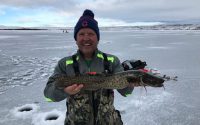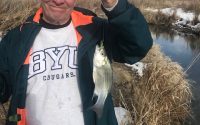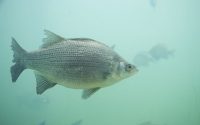The Best Laid Plans Often Go Astray . . .
In hopes of teaching a couple of my fishing buddies a new technique, Kirk Rasmussen and Kerry Ward joined me on a short excursion up the canyon to Deer Creek Reservoir to learn to “drop shot” for smallmouth bass.
This technique has been a large part of my fishing arsenal for nearly 20 years and has been the topic of several columns. However, as in so many topics, until you have someone actually “show” you how to do a thing, that “thing” will remain a mystery for a long time.
We arrived at Deer Creek State Park just after 6:00 a.m. and began fishing from my boat 20 minutes later.
The Drop Shot Technique
The drop shot technique includes a weight (on the bottom of the line), a light-wire small hook (tied to the main line 18 inches above the weight), and a plastic worm (generally 4 inches long) either nose hooked or Texas rigged.
Drop shot rigs are dropped to the bottom (at least when learning the technique) directly under the boat to fish that have been spotted on the screen of a fish finder. Originally, this technique was brought to this country from Japan, and it has grown in popularity for the better part of two decades. The idea is straight forward; find the fish, drop the rig to the bottom, entice the fish by shaking the rod tip without lifting the weight off the bottom, and wait for the fish to bite.
For teaching this technique, I like to find shallow flats in less and 20 feet of water. I also look for sandy, rock-strewn areas with little or no grass. This way, it is relatively easy to demonstrate the technique without worrying about getting snags or having difficulty seeing the fish on the finder due to an overabundance of bottom structure.
After finding a suitable spot, we located a small fish on the screen, dropped our rigs to the bottom, and … began catching six-inch smallmouth bass. Small fish kept taking our lures while larger fish didn’t have a chance to get in on the action.
The fish were so small that it was difficult to even know when you had a fish on your line. Kirk Rasmussen told us he wasn’t getting any bites so he reeled in to see if he still had his plastic worm on his hook only to discover a six-inch smallmouth that had most likely been hooked for several minutes.
All of us caught some small fish but we were not using the correct tackle for the day so we shifted gears, changed locations, lures, and methods resulting in more and much larger fish.
Changing Techniques
The larger smallmouth bass were chasing minnows (perhaps even the very fish we caught with our drop shots), so I began throwing a soft plastic jerkbait (fluke), Kerry Ward threw a small swimbait, and Kirk Rasmussen threw a curly-tailed grub. All of our lures were white. Almost instantly we all began catching smallmouth that averaged 12 to 13 inches and several fish approaching 2.5 pounds eventually ended up in the boat.
Kerry Ward had never used a swimbait but learned the method in just a few casts. Kirk Rasmussen had never used a grub but like Kerry, mastered the method and began catching bass in short order.
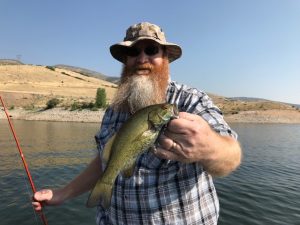
We caught and released at least 25 bass in the few hours we fished (we left the reservoir before the wake boarding boats took over), and had a great time learning three new techniques.
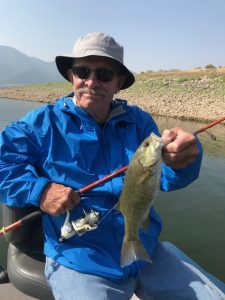
Yes, I wanted to teach them how to fish a drop shot, but in the end the bass told us they wanted to chase minnows on or near the surface, so our white flukes, swimbaits and grubs did the trick and we had a great day.
As in the title, if you plan to fish a certain way but your on-the-water observations make you question your decision, don’t be afraid to change baits, methods, areas or all of the above (if necessary) to turn lemons into lemonade.








